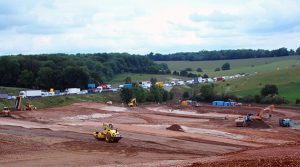Farm Impact Assessments
Thursday 2nd July 2020 in EIA & Soils

As a business RAC is regularly instructed by major developers, engineering and construction companies. When RAC becomes involved in these projects it is invariably because agricultural land and soils will be impacted. Development schemes include (but are not limited to!) residential development, infrastructure schemes, mineral extraction schemes, energy projects and waste management. As these large schemes become more prevalent, affecting more farmers and landowners, we thought now would be a good time to outline our role in these schemes and what to expect should you hear from us.
Our role on these projects is an important one, for both the developer and landowners and farmers. We often provide the first opportunity for affected landowners and farmers to learn more about the scheme, discuss potential impacts and possible ways in which these could be mitigated.
At this early stage, our first job is usually to identify the number of farm holdings we expect to be affected by the proposed scheme. This can be done in several ways but is usually achieved using aerial imagery (such as Google Earth), internet searches and some very skilled guess work! Occasionally the developer will already know which landowners will be affected and will already be in discussions with them. Where this is the case, we are usually able to skip the first step and contact landowners directly.
Once we have established who the affected landowners are likely to be, we will contact them with the hope of arranging a Farm Impact Assessment (FIA). The FIA meeting is an essential part of the process, it is of just as much importance to the farmer as it is to the developer. The FIA meetings generally take place around the kitchen table with the landowner and take 1-2 hours. Agents are also invited to join if their clients wish and projects will often have a policy of paying for a set number of hours of the agent’s time.
At the meeting we will discuss the ‘baseline conditions’ of the farming business including:
• the land area occupied and farmed and the basis upon which this land is occupied;
• the farming system (arable cropping, livestock etc) and any environmental schemes;
• diversifications; and
• location of main farm buildings etc.
We will then have a longer conversation to discuss the potential impacts of the proposed scheme on the farming business and ways in which these could potentially be overcome. At the early stages of scheme development this will usually be advising on specific farm accesses that need to be maintained or replaced, ‘hotspot’ areas of the farm that should be avoided if possible and the ways in which the farmer thinks the business will be affected by the proposed scheme.
At later stages of project development, and as the scheme design develops, we will be able to discuss more detailed design elements such as the location of ecological and landscape mitigation planting, balancing ponds and new farm access tracks or bridges.
These meetings provide a vital chance for farmers to engage with large development schemes that affect their businesses. The earlier farmers and landowners engage with us, the more influence we can have over the design of the scheme and mitigation measures to ensure that any effects on the farms are reduced.
We will also use the information gathered at the FIA meetings to assess the impacts of the proposed scheme on the affected farm businesses in the Environmental Impact Assessment that must be submitted as part of the planning application, Development Consent Order or Hybrid Bill. It is important to note that no personal or sensitive business information will be made public.
For more information on how large developments affect rural businesses and for more specific advice on Compulsory Purchase Orders (CPOs), the CAAV podcast ‘Good Practice in CPO Claims’ is well worth a listen.

